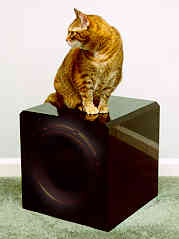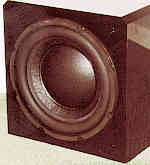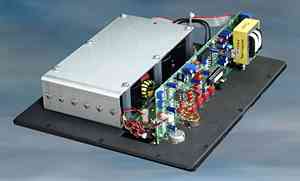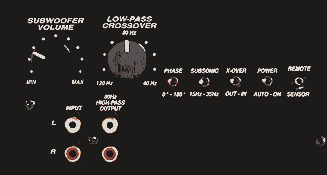Product Review - Velodyne HGS-12 Powered Subwoofer - February, 1998 J.E. Johnson, Jr.
 |
Velodyne HGS-12 Powered Subwoofer 12" Driver, Sealed Box, Servo-Feedback Manufacturer's FR Specs: 20 Hz - 125 Hz � 3 dB Built-in Amplifier: 1,250 watts rms Size: 14" H x 14" W x 14" D Weight: 47 pounds Price: $1,995 USA (Black gloss finish)
|
| Velodyne Acoustics, Inc., 1070 Commercial Street, Suite 101, San Jose, California 95112; Phone 408- 436-7270; Fax 408-436-7276; Web http://www.velodyne.com E-Mail [email protected]. |
Although we recently published a review of the Velodyne HGS-10 subwoofer, the innovative technology that is inherent to this new class of subwoofer warrants a review of their latest edition, the HGS-12. We understand that subwoofer aficionados in our readership want to know about the 12" version, and it will be some time before reviews appear in the printed trade. So here goes.
The HGS-12 (HGS stands for High Gain Servo) has a 12" driver
with a 19.3 pound magnet structure and 3" tandem push-pull voice coil.  This is the same driver as in the FSR-18,
without the bucking magnet. It is also the same driver as in the HGS-10.
This is the same driver as in the FSR-18,
without the bucking magnet. It is also the same driver as in the HGS-10.  Velodyne is quite pleased with the new driver design and is using
it in all of their high performance servo-feedback subwoofers, with the cone sized
accordingly. I really enjoy our F-1500s and FSR-18s, but they are BIG. The HGS-10 and
HGS-12 will fit nicely behind the couch if necessary. Is the size of the box that
important as far as being furniture-friendly? Apparently so to a lot of people. But the
problem has been in getting high performance from a small enclosure. Enter the HGS-10 and
HGS-12. In the HGS-12, the piston size is 11", and the actual edges of the mounting
rim extend the total driver size to 12". A large dust cap makes the driver shallow.
An enormous rubber surround allows for large excursion. The sub is powered by their new
digital switching (Class D) amplifier (140 kHz switching frequency at the output stage),
rated at 1,250 watts rms (that's a LOT of power!) into the driver which dips to 3.2 Ohms.
Servo-feedback technology is utilized (solid state motion detector mounted near the voice
coil), as is on all Velodyne high performance models.
Velodyne is quite pleased with the new driver design and is using
it in all of their high performance servo-feedback subwoofers, with the cone sized
accordingly. I really enjoy our F-1500s and FSR-18s, but they are BIG. The HGS-10 and
HGS-12 will fit nicely behind the couch if necessary. Is the size of the box that
important as far as being furniture-friendly? Apparently so to a lot of people. But the
problem has been in getting high performance from a small enclosure. Enter the HGS-10 and
HGS-12. In the HGS-12, the piston size is 11", and the actual edges of the mounting
rim extend the total driver size to 12". A large dust cap makes the driver shallow.
An enormous rubber surround allows for large excursion. The sub is powered by their new
digital switching (Class D) amplifier (140 kHz switching frequency at the output stage),
rated at 1,250 watts rms (that's a LOT of power!) into the driver which dips to 3.2 Ohms.
Servo-feedback technology is utilized (solid state motion detector mounted near the voice
coil), as is on all Velodyne high performance models.  There are 78.6 joules of energy storage
capacity in the power amplifier. On the back are an ungrounded AC socket, RCA line-level
inputs and high-pass (80 Hz, 6 dB/octave) outputs, Volume control, Low-Pass crossover
control (40 Hz - 120 Hz, 12 dB/octave initially, 48 dB/octave ultimately), Crossover
in/out switch, Phase toggle (00 or 1800), Subsonic selection (20 Hz
or 35 Hz cutoff), and a remote sensor socket. The enclosure is nicely finished in gloss
black polymer veneer.
There are 78.6 joules of energy storage
capacity in the power amplifier. On the back are an ungrounded AC socket, RCA line-level
inputs and high-pass (80 Hz, 6 dB/octave) outputs, Volume control, Low-Pass crossover
control (40 Hz - 120 Hz, 12 dB/octave initially, 48 dB/octave ultimately), Crossover
in/out switch, Phase toggle (00 or 1800), Subsonic selection (20 Hz
or 35 Hz cutoff), and a remote sensor socket. The enclosure is nicely finished in gloss
black polymer veneer.
For testing (listening and measurements), we placed the HGS-12 on the floor, 2 feet out from a wall. The 20' x 20' testing lab has wall to wall carpet, and no windows. The HGS-12 complimented our McCormack CD system, McCormack ALD-1 Preamplifier, LLano Monoblocks, and Threshold ES-500 Electrostatic Speakers. Cables were Nordost SPM Reference and Nordost Red Dawn. For room response measurements, the low pass was set to 120 Hz, the crossover switch was set to "In", and the subsonic cutoff was set at 20 Hz. The volume control was at mid-level.
| Room Response - Velodyne HGS-12 Subwoofer -- Grille off -- Set to 90 dB at 20 Hz -- (This is not maximum output, but rather just the response in an "average" room with the volume set to 90 dB at 20 Hz.) |
| 1 meter | 13 feet |
| 10 Hz | 72.7 dB | 10 Hz | 82.4 dB |
| 12.5 Hz | 69.0 dB | 12.5 Hz | 86.4 dB |
| 16 Hz | 80.6 dB | 16 Hz | 92.1 dB |
| 20 Hz | 90.4 dB | 20 Hz | 90.7 dB |
| 25 Hz | 93.8 dB | 25 Hz | 98.7 dB |
| 31.5 Hz | 97.3 dB | 31.5 Hz | 103.6 dB |
| 40 Hz | 88.1 dB | 40 Hz | 104.4 dB |
| 50 Hz | 95.8 dB | 50 Hz | 101.2 dB |
| 63 Hz | 92.3 dB | 63 Hz | 107.0 dB |
| 80 Hz | 93.3 dB | 80 Hz | 94.0 dB |
| 100 Hz | 93.2 dB | 100 Hz | 98.4 dB |
| 125 Hz | 85.9 dB | 125 Hz | 97.9 dB |
| 160 Hz | 81.7 dB | 160 Hz | 87.4 dB |
The HGS-12 has usable output down to 16 Hz (farfield). Even in the deep regions at high output, we could hear no harmonics, and our Spectrum Analyzer showed no harmonic peaks within about 20 dB of the fundamental (the sinewave test frequency). We could get 112 dB SPL nearfield at 31.5 Hz, which is similar to an F-1500, before limiters set in. I never heard the HGS-12 amplifier clip. That isn't to say that it can't be done, but the limiters keep this from happening under normal circumstances. This new digital switching amplifier stuff is really amazing!
The built-in amplifier remained stone cold even after extensive use at full output. Notwithstanding problems they might have with full spectrum sound, they sure make dynamite amplifiers for subwoofers! Our ES-500 Electrostatic Speakers are full range units, and even though they respond to quite low frequencies, it is hard work. I used our Mirage LFX-3 active crossover to attenuate frequencies below 50 Hz in the electrostatics, and the HGS-12 made a huge difference in the overall sound presentation. The electrostatic panels were alleviated from having to handle the lows, making them perform better in the mids and highs, while the HGS-12 moved all the air necessary to make the wall studs shudder. Of course, the HGS-12 was great with home theater material, but putting this sub with the $11,000 ES-500s was illuminating as to its high performance capability in the realm of classical music. Powerful, deep, and clean. Nothing else needs to be said.
In summary, the HGS-12 is the big brother to the HGS-10, and both are new additions to Velodyne's line of servo-feedback subwoofers. Although neither of these products will stomp on the Velodyne FSR-18, the HGS-12 sure will make you scratch your chin when deciding between it and conventional 15" subs.
John E. Johnson, Jr.
![]()
� Copyright 1998 Secrets of Home Theater & High Fidelity
Return to Table of Contents for this Issue.

